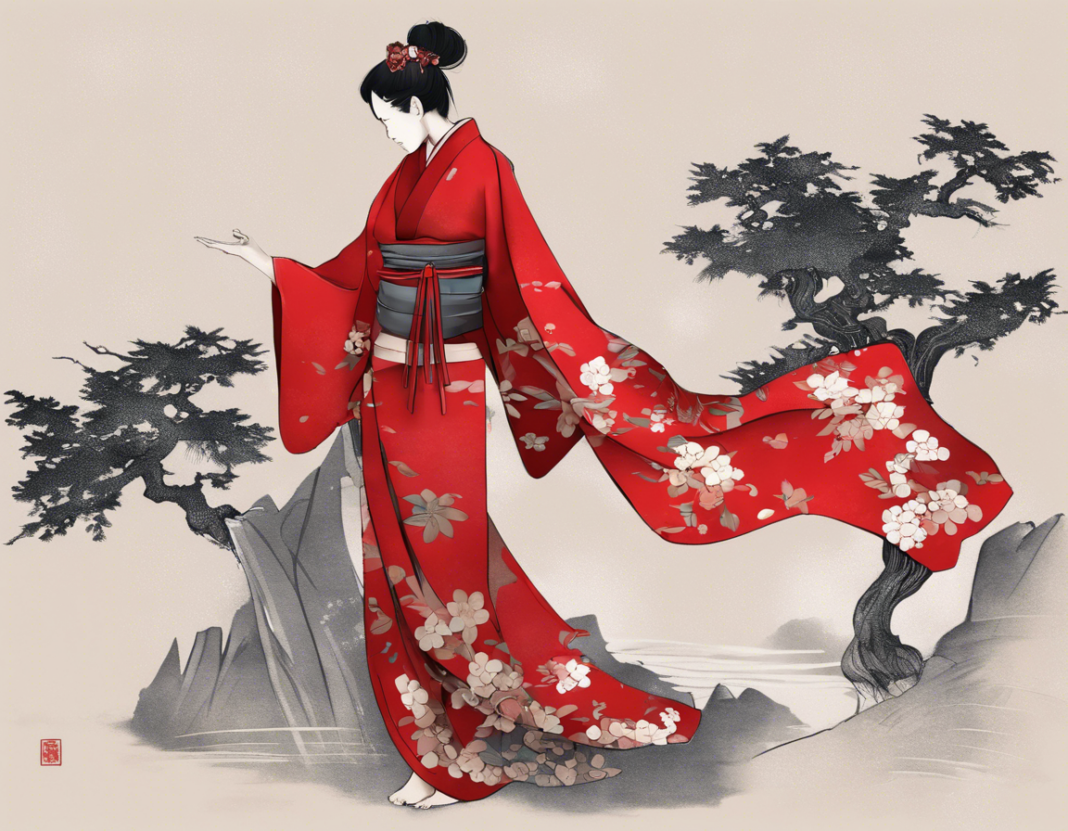Introduction:
The red kimono holds a special place in Japanese culture and fashion. Its vibrant hue and intricate design have captivated people around the world. In this article, we will delve into the history, significance, and beauty of the red kimono.
History of the Red Kimono:
The kimono itself has been a traditional Japanese garment for centuries, tracing its origins back to the Heian period (794-1192). The kimono was initially worn as a simple garment, but over time, it evolved into a symbol of status and elegance. The color red, in particular, has been a popular choice for kimonos due to its association with vitality, power, and good fortune in Japanese culture.
During the Edo period (1603-1868), the red kimono became even more prevalent among the nobility and samurai. The garment was often adorned with intricate patterns and motifs that reflected the wearer’s social status and personal style. Red kimonos were also worn during special occasions such as weddings, festivals, and ceremonies, further cementing their significance in Japanese society.
Symbolism of the Red Kimono:
In Japanese culture, colors hold symbolic meanings, and red is no exception. The color red is associated with energy, passion, and vitality. It is also considered a protective color, believed to ward off evil spirits and bring good luck. When worn as a kimono, red symbolizes auspiciousness and joy, making it a popular choice for celebrations and auspicious events.
Types of Red Kimonos:
There are several types of red kimonos, each with its own unique style and significance:
-
Furisode: A formal, long-sleeved kimono often worn by young unmarried women during coming-of-age ceremonies or weddings. Red furisode kimonos are adorned with elaborate designs and are considered a symbol of beauty and elegance.
-
Iromuji: A single-color kimono that is typically worn for semi-formal occasions. Red iromuji kimonos are versatile and can be accessorized with different obi (sashes) to suit the occasion.
-
Houmongi: A formal kimono with a flowing pattern that stretches across the seams. Red houmongi kimonos are often chosen for weddings and special events due to their elaborate designs.
-
Tomesode: A formal kimono with shorter sleeves, typically worn by married women. Red tomesode kimonos are reserved for special occasions such as weddings of close relatives or formal ceremonies.
Styling the Red Kimono:
Styling a red kimono involves careful consideration of accessories, obi (sash), and footwear. Here are some tips for styling a red kimono:
- Choose a complementary obi that enhances the red hue of the kimono.
- Accessories such as hairpieces, kanzashi (ornamental hairpins), and jewelry can add a touch of elegance to the ensemble.
- Select appropriate footwear such as zori or geta sandals to complete the look.
Celebrating the Red Kimono:
The beauty of the red kimono is celebrated in various ways in modern Japan. Kimono fashion shows, exhibitions, and festivals showcase the exquisite craftsmanship and artistry that go into creating these timeless garments. Many young people are also embracing the beauty of the red kimono by incorporating it into their everyday wardrobe or special occasions.
FAQs about the Red Kimono:
- Can men wear red kimonos?
-
Yes, men can wear red kimonos, especially for formal events such as weddings or ceremonies.
-
What accessories should I pair with a red kimono?
-
Accessories such as obi, obidome (obi clips), kanzashi, and silk scarves complement a red kimono beautifully.
-
Are there specific patterns or motifs associated with red kimonos?
-
Red kimonos may feature motifs such as cranes, cherry blossoms, or geometric patterns, each symbolizing different meanings.
-
Can I wear a red kimono for casual outings?
-
While red kimonos are traditionally worn for formal events, modern interpretations allow for wearing them on casual outings with a contemporary twist.
-
How do I care for a red kimono?
- Red kimonos should be dry-cleaned to preserve their color and fabric quality. It is essential to store them properly to prevent fading or damage.
Conclusion:
The red kimono exemplifies the rich cultural heritage and timeless elegance of Japanese fashion. Its vibrant color and intricate design continue to inspire designers, artists, and fashion enthusiasts worldwide. Whether worn for special occasions or as a fashion statement, the red kimono embodies beauty, tradition, and grace.









